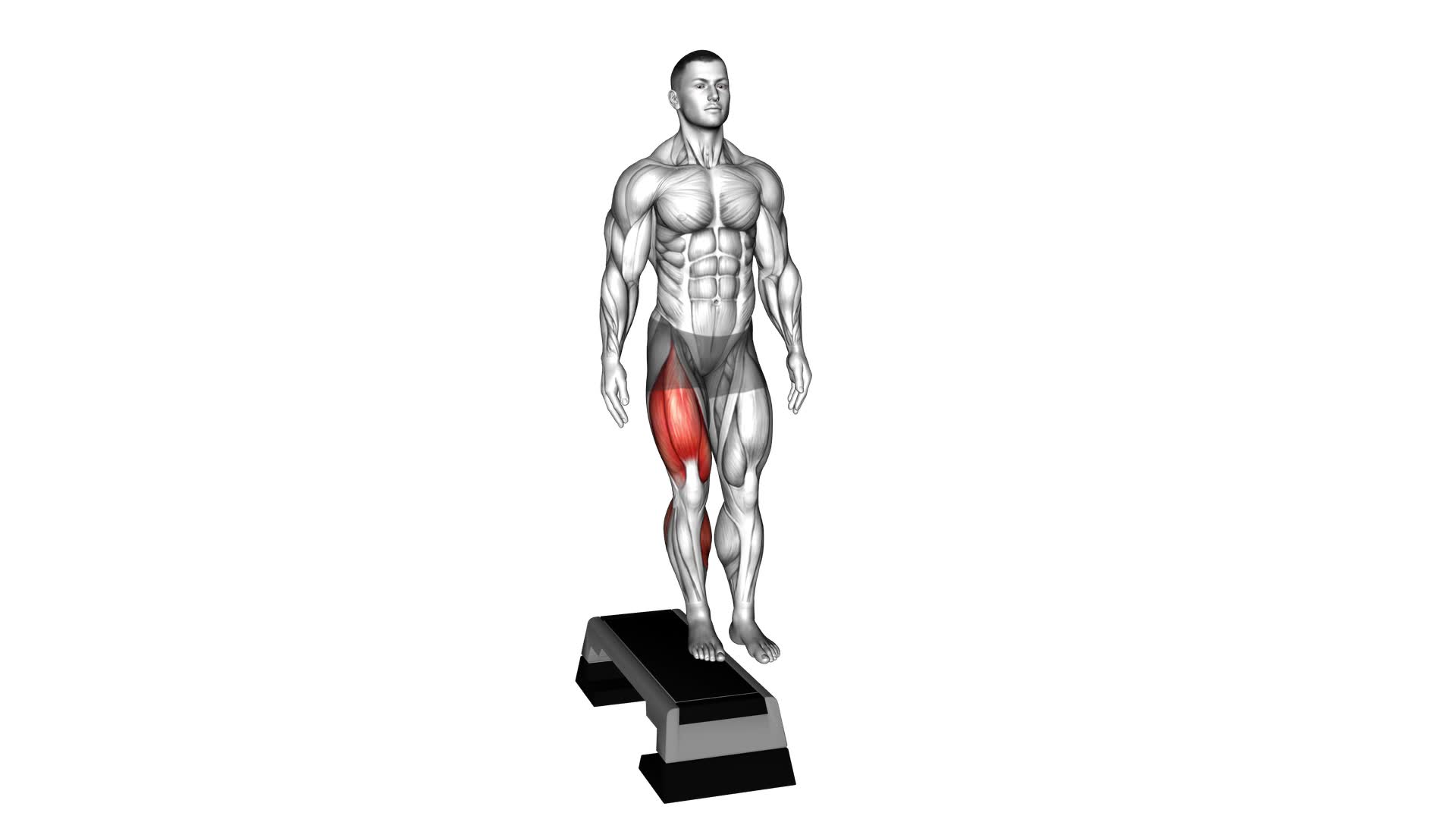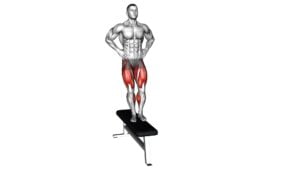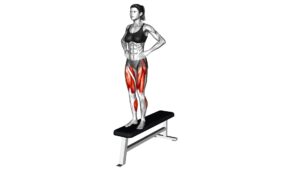Lateral Step-up – Video Exercise Guide & Tips

Looking to add a challenging and effective exercise to your workout routine? Check out the Lateral Step-Up!
Watch This Exercise Video
This video exercise guide and tips will show you the proper form and technique to get the most out of this exercise. Whether you're a beginner or looking to challenge yourself, there are variations to suit your fitness level.
Incorporating lateral step-ups into your workouts can help improve your strength, stability, and overall lower body function.
Let's get stepping!
Key Takeaways
- Lateral step-ups increase strength and stability in the lower body.
- They target the glute muscles for improved hip extension and abduction.
- Lateral step-ups enhance overall lower body strength and posture.
- They support the body during activities like running, jumping, and squatting.
Benefits of Lateral Step-ups
You can experience increased strength and stability in your lower body by incorporating lateral step-ups into your exercise routine. Lateral step-ups are a highly effective exercise that targets your glutes while also improving balance.
When you perform lateral step-ups, you engage your glute muscles, which are responsible for hip extension and hip abduction. By strengthening your glutes, you not only improve the appearance of your buttocks but also enhance your overall lower body strength. Strong glutes play a crucial role in maintaining good posture, preventing injuries, and supporting your body during various activities such as running, jumping, and squatting.
In addition to targeting your glutes, lateral step-ups also help improve your balance. The exercise requires you to shift your weight from side to side, challenging your body's stability. As you step up onto a raised platform or bench, you activate the muscles in your legs and core to maintain balance and control throughout the movement. Over time, this can lead to better overall balance and coordination, which are essential for daily activities and sports performance.
To reap the benefits of lateral step-ups, start by standing beside a bench or platform. Place one foot on the bench, push through your heel, and lift your body up until your leg is straight. Lower yourself back down and repeat on the other side. Aim for 2-3 sets of 10-12 repetitions on each leg, gradually increasing the difficulty by adding weights or raising the height of the platform.
Incorporating lateral step-ups into your exercise routine can help you strengthen your glutes, improve your balance, and enhance the stability of your lower body.
Proper Form and Technique
To perform lateral step-ups with proper form and technique, ensure that your foot is securely placed on the bench or platform before pushing through your heel and lifting your body up until your leg is straight. This is the key to executing the exercise correctly and maximizing its benefits.
One common mistake people make isn't fully extending their leg when they lift their body up. It's important to fully straighten your leg to engage the muscles in your glutes, hamstrings, and quadriceps. Another common misconception is using your toes instead of your heel to push off the bench. By using your heel, you activate your glutes and hamstrings more effectively, resulting in a more efficient and beneficial workout.
Remember to maintain a steady pace throughout the exercise and avoid swinging your leg or using momentum to lift your body. This ensures that you're solely relying on the strength of your leg muscles to perform the movement, making the exercise more challenging and effective.
Now that you have mastered the proper form and technique of lateral step-ups, let's explore some variations to challenge yourself even further.
Variations to Challenge Yourself
Building upon the proper form and technique discussed, let's explore some ways to challenge yourself with variations of the lateral step-up exercise.
To take your lateral step-ups to the next level, you can try incorporating advanced modifications and equipment options.
One advanced modification you can try is adding weight to the exercise. This can be done by holding dumbbells or a kettlebell in your hands as you perform the step-ups. The added resistance will increase the difficulty and help to build strength in your lower body.
Another variation is to increase the height of the step. Using a higher platform will require more strength and stability, intensifying the workout. You can gradually increase the height as you progress, challenging your muscles even further.
If you have access to gym equipment, you can use a resistance band to add resistance to the exercise. Place the band around your thighs or ankles and perform the lateral step-ups as usual. The resistance provided by the band will engage your muscles in a different way, making the exercise more challenging.
Tips for Beginners
Start off by mastering the basic technique of the lateral step-up exercise. As a beginner, it's important to be aware of common mistakes and misconceptions that can hinder your progress.
One common mistake is relying too much on the upper body for support instead of engaging the lower body muscles. Remember to focus on pushing through your heel as you step up, using your glutes and quads to power the movement.
Another mistake is using too much momentum to lift your leg, which can compromise your form and increase the risk of injury. Take it slow and controlled, ensuring that you maintain proper form throughout the exercise.
A common misconception is that lateral step-ups only work the legs. While they do primarily target the lower body muscles, they also engage the core and improve balance and stability.
Incorporating lateral step-ups into your workout routine can be an effective way to strengthen your legs and improve overall athletic performance. They can also be modified to increase the challenge as you progress.
Incorporating Lateral Step-Ups Into Your Workout Routine
Once you have mastered the basic technique of the lateral step-up exercise, incorporate it into your workout routine to enhance leg strength and overall athletic performance. Here are three ways to incorporate lateral step-ups into your routine:
- Lateral Step Up Modifications: Start by adding weights to increase the intensity of the exercise. Hold dumbbells or a kettlebell in your hands while performing the step-up. You can also use a higher step or platform to challenge yourself further. Additionally, you can try performing the exercise on one leg to target specific muscles and improve balance.
- Lateral Step Up Progressions: Once you're comfortable with the basic lateral step-up, you can progress to more advanced variations. One option is to perform the exercise with a knee drive at the top of the movement, engaging your core and adding a balance challenge. Another progression is to incorporate a hop or jump onto the step, increasing the plyometric nature of the exercise and boosting power and explosiveness.
Remember to start with a weight and height that's challenging yet manageable for your fitness level. Gradually increase the difficulty as you become more comfortable and stronger.
Frequently Asked Questions
How Many Calories Can I Burn by Doing Lateral Step-Ups?
You can burn a significant amount of calories by doing lateral step-ups. The exact number of calories burned will depend on factors such as your weight, intensity, and duration of the exercise.
Lateral step-ups offer various variations that can further increase the calorie burn, such as using weights or incorporating jumps.
Can Lateral Step-Ups Help Improve My Balance and Stability?
Lateral step-ups are a great exercise to improve your balance and stability. Athletes can benefit from this exercise as it targets the muscles used for lateral movements, which are important for agility and quick direction changes.
To progress as an advanced user, you can increase the height of the step or add weights for added resistance.
Can I Do Lateral Step-Ups if I Have Knee or Hip Pain?
If you have knee or hip pain, you may wonder if you can do lateral step-ups. Lateral step-ups can actually be beneficial for knee pain and hip pain.
They can help strengthen the muscles around your knees and hips, which can improve stability and reduce pain.
However, it's important to start with a low step height and listen to your body. If you experience any discomfort, it's best to consult with a healthcare professional before continuing with this exercise.
Is It Better to Use Weights or Bodyweight for Lateral Step-Ups?
When it comes to lateral step-ups, you may wonder whether it's better to use weights or stick to bodyweight. Both options have their benefits.
Using weights can increase the intensity and challenge your muscles even more. It can also help with building strength and muscle mass.
On the other hand, bodyweight lateral step-ups are a great option for beginners or those who prefer a less intense workout.
Ultimately, the choice depends on your fitness goals and personal preferences.
How Often Should I Include Lateral Step-Ups in My Workout Routine for Maximum Results?
For maximum results, it's important to include lateral step-ups in your workout routine with the right frequency.
The frequency will depend on your current fitness level and goals. Start by incorporating them 1-2 times per week, and as you progress, you can increase the frequency to 3-4 times per week.
This will help challenge your muscles and promote strength and endurance development.
Don't forget to gradually increase the difficulty by adding weights or progressing to more advanced variations for continued improvement.
Conclusion
In conclusion, lateral step-ups are a beneficial exercise for strengthening the lower body, improving balance, and increasing stability.
By following proper form and technique, incorporating variations, and gradually challenging yourself, you can maximize the benefits of this exercise.
Whether you're a beginner or advanced, incorporating lateral step-ups into your workout routine can help you achieve your fitness goals.
Keep practicing and enjoy the results!

Author
Years ago, the spark of my life’s passion ignited in my mind the moment I stepped into the local gym for the first time. The inaugural bead of perspiration, the initial endeavor, the very first surge of endorphins, and a sense of pride that washed over me post-workout marked the beginning of my deep-seated interest in strength sports, fitness, and sports nutrition. This very curiosity blossomed rapidly into a profound fascination, propelling me to earn a Master’s degree in Physical Education from the Academy of Physical Education in Krakow, followed by a Sports Manager diploma from the Jagiellonian University. My journey of growth led me to gain more specialized qualifications, such as being a certified personal trainer with a focus on sports dietetics, a lifeguard, and an instructor for wellness and corrective gymnastics. Theoretical knowledge paired seamlessly with practical experience, reinforcing my belief that the transformation of individuals under my guidance was also a reflection of my personal growth. This belief holds true even today. Each day, I strive to push the boundaries and explore new realms. These realms gently elevate me to greater heights. The unique combination of passion for my field and the continuous quest for growth fuels my drive to break new ground.







